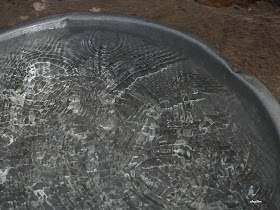Our tropical country has two seasons, Dry and Wet. Our temperate country friends might be surprised how we live our whole life with just a Dry and a Wet Season. They are actually sometimes very dry and/or very wet. But these are just the main differences. There are also variations among regions of the country where we have currently eighteen, 17 administrative and 1 autonomous region. We have also 4 climate types and sub-types. This is the reason that my garden in the province has a very distinct long dry season and a wet season, typical of Type I climate. On the other hand, an area in Region VIII has a standing joke with its climate, as wet and very wet, because it has Type IV climate that is supposed to have evenly distributed rainfall throughout the year.
I am a PLUVIOPHILE, someone who loves rain, finds joy and peace of mind during rainy days. Our official rainy season started in June, so you bet, i am at my best these days.
I find raindrops on taro leaves very artistic and exceptional,
I find this basin-full of rain so lovely with the abstract patterns as rains fall
I find even this wet tube so nice with that bokeh background
I find the ground puddles welcoming of diverse organisms, expressing joy itself
....the weeds so joyous swaying their leaves and flower with the wind
....the complex growth of colors in one side of mother's biodiversity garden
....the growth of mosses luxuriantly embracing the otherwise bare vertical ground wall
....the young leaves so attractive distinctly showing their colorful innocense
....the butterflies suddenly metamorphosed to adults cued in finding new food
....the butterflies freely roam again among new nectar plants
....even the birds twitter more happily, preening themselves more freely now
.... the dormant hippeastrum ressurected to blooms again
....the dormant caladiums can display their fancy color displays again
...the above bald path during the dry season is now full of grasses and weeds; and my hoyas washed their leaves of the dry season dust, showing contentment, displaying luster
.... and my morning views upon opening my eyes most mornings are more dramatic with the clouds!
A pluviophile enjoys all these, finds joy in everything brought by the rain, and the above photos are just within the vicinity or our house and just around the garden. If i move my camera beyond my space, there will be more, and that will be for maybe the future posts.
I hope you found some information about my world, and myself, your blogger friend.




































